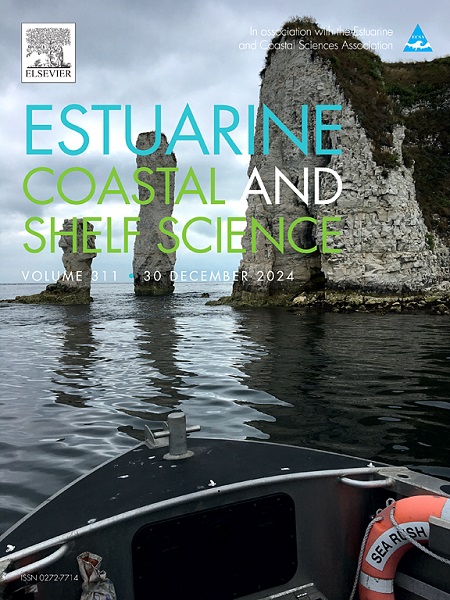Phytoplankton dynamics and responses to two extreme events in the Gulf of Venice, Northern Adriatic Sea, Italy
IF 2.6
3区 地球科学
Q1 MARINE & FRESHWATER BIOLOGY
引用次数: 0
Abstract
This study, based on 12 years of regular monthly observations, aimed to describe the prevalent seasonal pattern and taxonomic composition of the phytoplankton community at the Italian Long-Term Ecological Research (LTER-Italy) site, Acqua Alta Oceanographic Tower (LTER-AAOT), a coastal region of the NWAS (North-Western Adriatic Sea), characterized by significant variability in oceanographic conditions. Although studies on phytoplankton communities in this region dates back to the 1960’, this dataset represent the first systematic and regular observations. Over this period, two years - 2014 and 2022 – stood due to their distinctive climatic conditions: extreme rainfall (2014) and severe drought (2022). According to the Intergovernmental Panel on Climate Change (IPCC), such events are expected to become more frequent and intense in the future. Therefore, we also analysed phytoplankton changes during these two years, to explore the potential impact of extreme weather events on phytoplankton dynamics in this coastal area. The prevalent phytoplankton seasonal cycle is bimodal, with a growing season that starts in late winter and continues until early summer, followed by a decline in summer, and a second growth pulse in early autumn. Diatoms and undetermined nanoflagellates dominate throughout the year. Various taxa of dinoflagellates taxa are present in summer, though in low abundances, while coccolithophores (i.e. calcified Prymnesiophyceae) are present in winter. Despite significant variability in abiotic factors, this seasonal and taxonomic pattern remains a consistent feature of the phytoplankton community highlighting the overall variability of the LTER site as well as its similarities with other areas of the Northern Adriatic Sea. The study also suggests potential shifts in phytoplankton patterns in response to extreme weather events, indicating a trend toward more oligotrophic conditions during droughts and increased brackish water influence under most rainy scenarios. These findings contribute to a better understanding of the future dynamics of coastal phytoplankton communities in the context of climate change.

意大利北部亚得里亚海威尼斯湾浮游植物动态及其对两次极端事件的响应
本研究基于12年的定期月度观测,旨在描述意大利长期生态研究(LTER-Italy)站点,Acqua Alta海洋塔(LTER-AAOT)浮游植物群落的普遍季节格局和分类组成,该站点是NWAS(西北亚得里亚海)沿海地区,具有显著的海洋条件变化特征。虽然对该地区浮游植物群落的研究可以追溯到20世纪60年代,但该数据集代表了第一次系统和定期的观测。在此期间,2014年和2022年这两年因其独特的气候条件而停滞不前:极端降雨(2014年)和严重干旱(2022年)。据政府间气候变化专门委员会(IPCC)称,预计未来此类事件将变得更加频繁和激烈。因此,我们也分析了这两年浮游植物的变化,以探讨极端天气事件对该沿海地区浮游植物动态的潜在影响。普遍的浮游植物季节循环是双峰的,生长季节从冬末开始,一直持续到夏初,然后是夏季的下降,在初秋开始第二次生长脉冲。硅藻和未确定的纳米鞭毛虫全年占主导地位。各种鞭毛类的分类群存在于夏季,尽管丰度较低,而球石藻(即钙化的原毛藻)存在于冬季。尽管非生物因素存在显著的变异性,但这种季节性和分类模式仍然是浮游植物群落的一贯特征,突出了LTER站点的整体变异性以及与北亚得里亚海其他地区的相似性。该研究还表明,在极端天气事件的影响下,浮游植物的模式可能会发生变化,表明在干旱期间,浮游植物的营养状况会越来越少,而在大多数多雨的情况下,微咸水的影响会增加。这些发现有助于更好地理解气候变化背景下沿海浮游植物群落的未来动态。
本文章由计算机程序翻译,如有差异,请以英文原文为准。
求助全文
约1分钟内获得全文
求助全文
来源期刊
CiteScore
5.60
自引率
7.10%
发文量
374
审稿时长
9 months
期刊介绍:
Estuarine, Coastal and Shelf Science is an international multidisciplinary journal devoted to the analysis of saline water phenomena ranging from the outer edge of the continental shelf to the upper limits of the tidal zone. The journal provides a unique forum, unifying the multidisciplinary approaches to the study of the oceanography of estuaries, coastal zones, and continental shelf seas. It features original research papers, review papers and short communications treating such disciplines as zoology, botany, geology, sedimentology, physical oceanography.

 求助内容:
求助内容: 应助结果提醒方式:
应助结果提醒方式:


